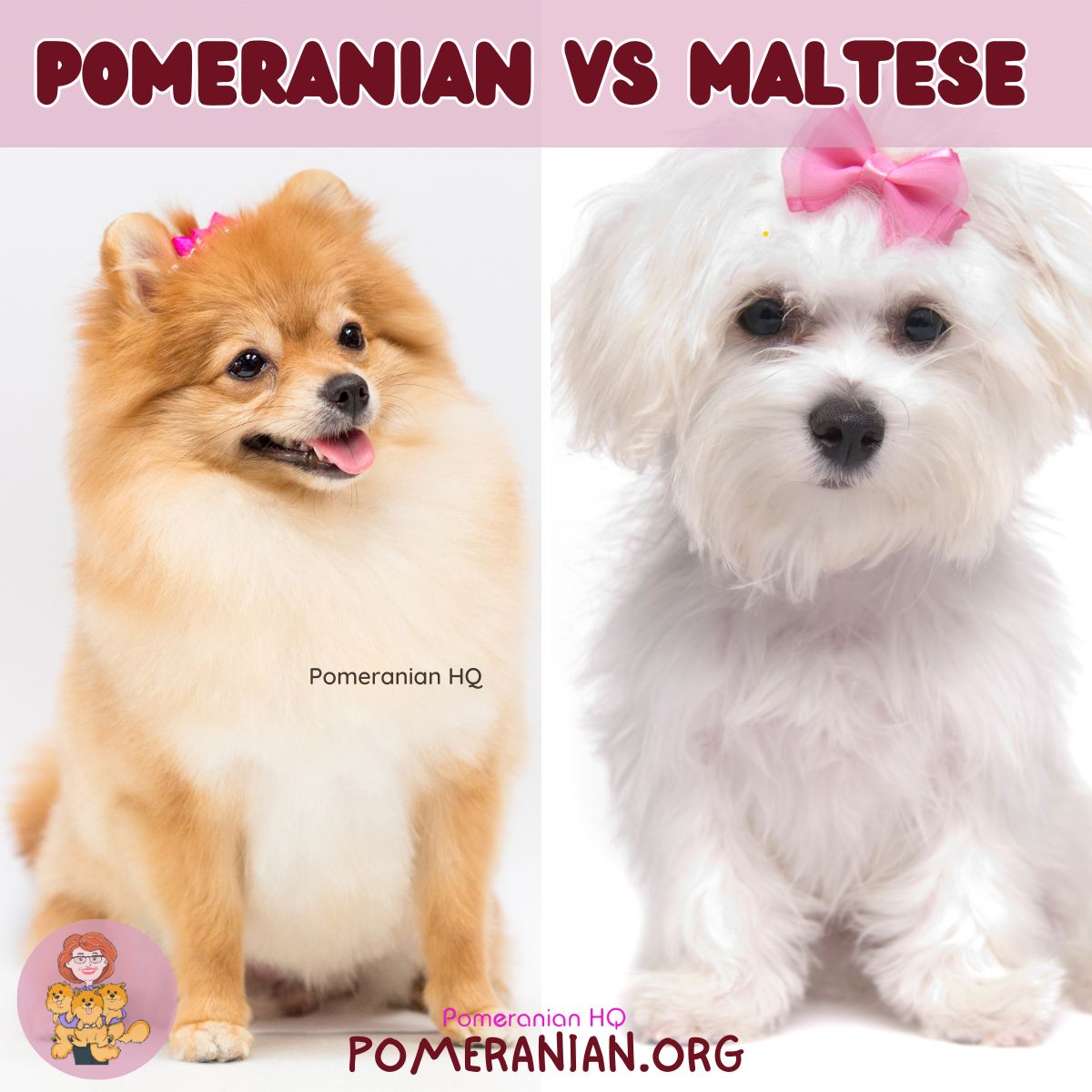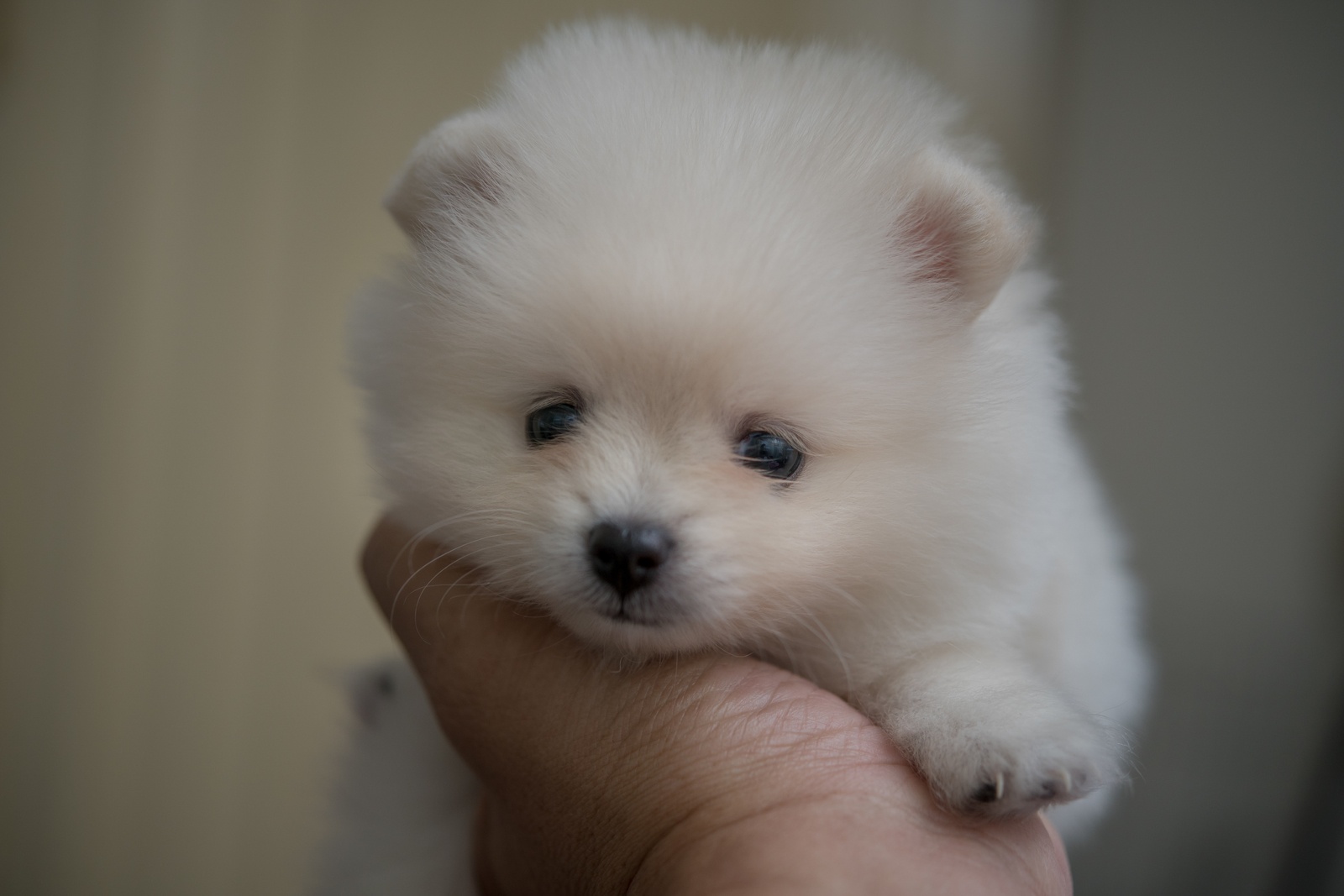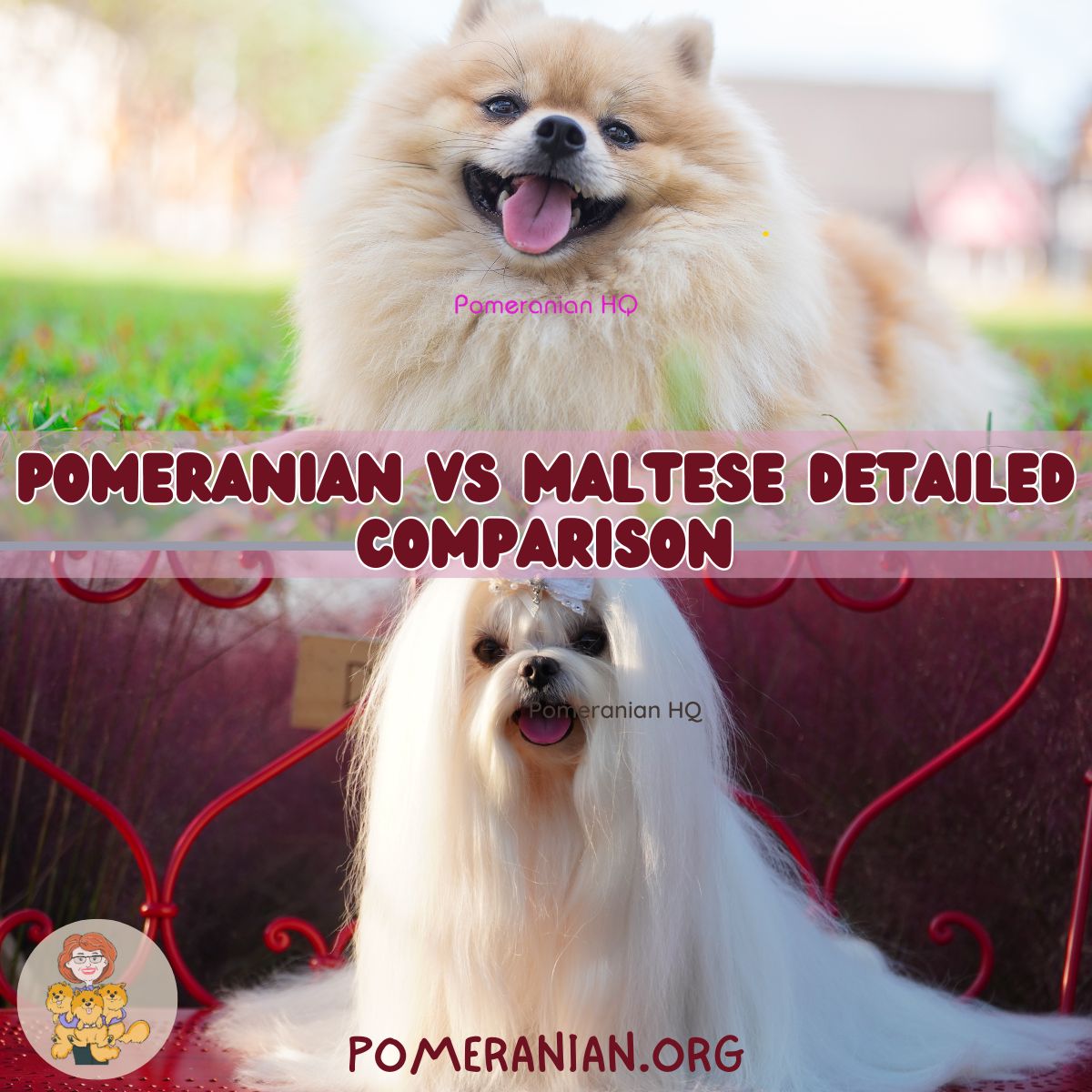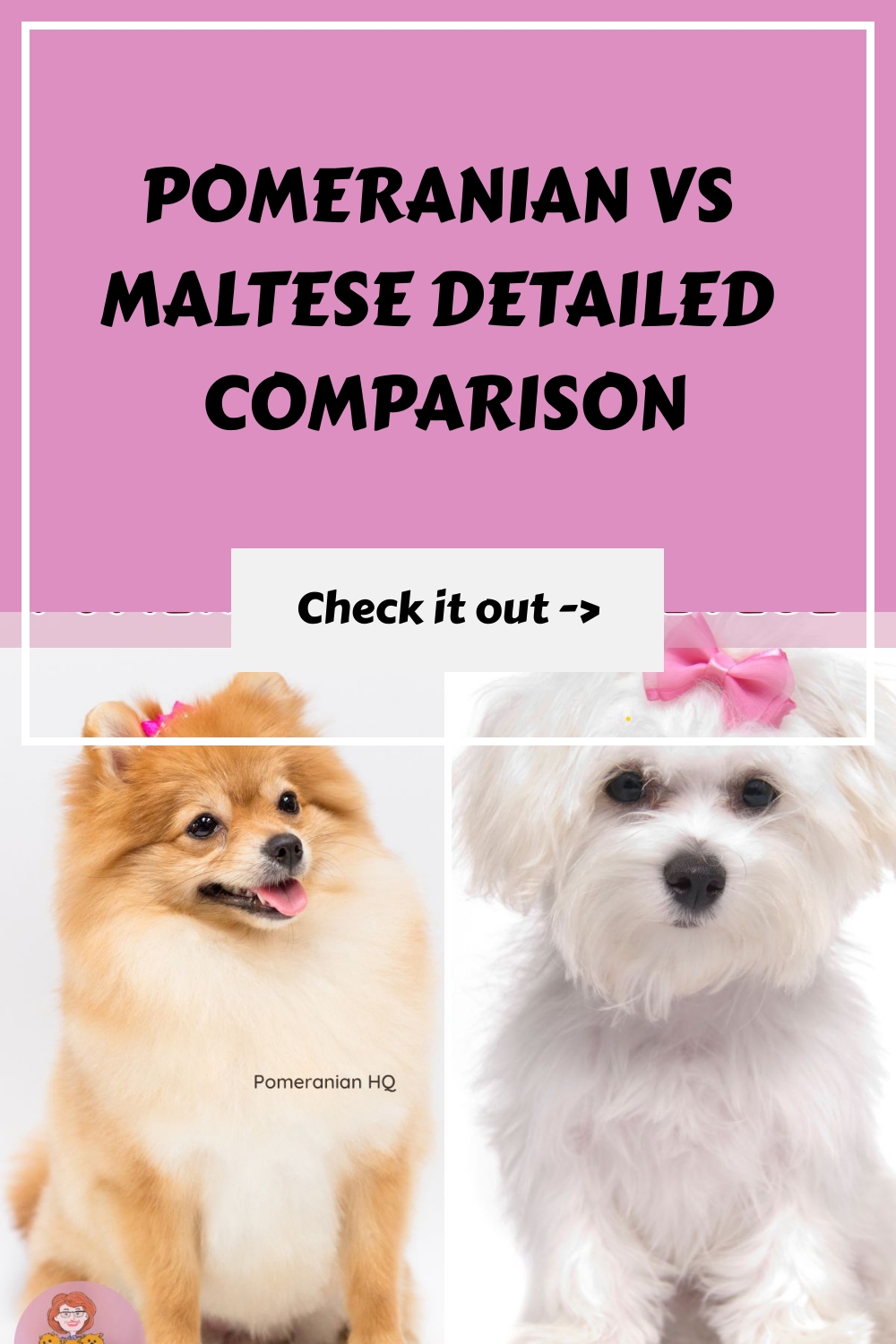Last Updated on 09/04/2024 by Denise Leo. Post first published on February 14, 2024.
Choosing between two of the most adorable and beloved toy dog breeds, the Pomeranian and the Maltese, can be a delightful yet challenging decision for potential dog owners. Both breeds boast a rich history, distinctive looks, and engaging personalities that can easily captivate anyone’s heart. However, regarding Pomeranian vs Maltese, understanding the subtle and not-so-subtle differences between these two breeds is crucial for finding the perfect furry companion that aligns with your lifestyle, preferences, and expectations.
The Pomeranian, with its fluffy coat and energetic personality, is often seen as the epitome of a lap dog with the heart of a lion, showcasing a bold and adventurous spirit. On the other hand, the Maltese, known for its elegant white mantle and gentle demeanor, epitomizes grace and loyalty, making it a beloved companion for those who cherish a serene and affectionate pet. Each breed presents unique qualities and challenges, from their size and temperament to their grooming needs and health considerations.
In this article, we will embark on a comprehensive journey to explore the intricacies of Pomeranian vs. Maltese. We aim to provide valuable insights to help you decide which breed could be the best addition to your family.
Whether you are drawn to the spirited nature of the Pomeranian or the tranquil companionship of the Maltese, understanding these breeds in depth will ensure that your choice leads to a rewarding and lasting relationship with your new four-legged friend.

The Origins of the Pomeranian Breed
The origins of the Pomeranian breed trace back to the vast, icy landscapes of the Arctic and Northern Europe, where they descended from the ancient Spitz family of dogs. Known for their resilience and adaptability, these early ancestors of today’s Pomeranian dogs were significantly larger, bred to work hard in the harsh climate, herding animals and pulling sleds.
The transformation from a robust, work-oriented dog to the petite and affectionate companion we know today began in the Pomerania region, now part of modern-day Poland and Germany. It is from this region that the breed inherited its name, becoming a symbol of the area’s rich cultural heritage.
Over the centuries, selective breeding focused on reducing their size while retaining the Spitz’s distinctive features, such as plush coats, fox-like faces, and spirited personalities, leading to the “little dogs” that would captivate hearts worldwide.
The breed’s journey to becoming a beloved household pet saw a significant turning point during the 19th century when Queen Victoria of England fell in love with a Pomeranian dog. Her affection for the breed and her influence on its breeding practices led to a decrease in their size by nearly half, making them even more desirable as companion animals.
This royal endorsement catapulted the Pomeranian to fame across Europe and eventually to the United States, where the American Kennel Club officially recognized them in the late 19th century.
In the United States, Pomeranian dogs quickly became a symbol of luxury and high society, a status they maintain today. Their charming appearance and lively and affectionate temperament have made them one of the most popular breeds among dog lovers, especially those who appreciate the unique qualities of Spitz dog breeds.

The Historical Background of the Maltese Dog
With its elegant and refined appearance, the Maltese breed holds a storied place in history as one of the oldest companion dogs known to humanity. Originating from the central Mediterranean area, the breed’s name is thought to derive from the island of Malta or possibly from the Adriatic island of Meleda; however, its association with these locales over the centuries has imbued the Maltese with a sense of ancient prestige.
Throughout history, the Maltese have been cherished by aristocrats and royalty alike, symbolizing wealth and luxury. These small breeds have been depicted in art and literature throughout ancient Greek, Roman, and Egyptian cultures, indicating their long-standing status as favored companions.
Maltese dogs, with their distinctive long, flowing white coats, have always been admired for their beauty and grace. Beyond their aesthetic appeal, the Maltese breed has been valued for its gentle and affectionate nature, making it the quintessential lapdog.
Throughout the ages, these companion dogs have been bred specifically for their small size and loving temperament, which endeared them to people across various cultures and epochs. The breed’s enduring popularity is a testament to its ability to form deep, emotional connections with its owners, offering comfort and companionship.
Today, the Maltese continues to be celebrated for its physical beauty, spirited personality, and unwavering loyalty, embodying the ideal characteristics sought after in companion dogs.
Pomeranian vs Maltese Size: A Comparative Analysis
When comparing the size of Pomeranian and Maltese dogs, both breeds fall into the category of small dogs, with specific characteristics that set them apart within the toy group. The Pomeranian, known for its fluffy coat and spirited personality, boasts a small stature that belies its bold demeanor.
Pomeranians weigh between 3 to 7 pounds, making them one of the smallest dog breeds. However, despite their diminutive size, they carry themselves with a confident and lively presence that sometimes gives the impression of a larger dog.
On the other hand, the Maltese breed, celebrated for its elegant and silky white coat, also features a small stature that defines its classification as a toy dog. Maltese tend to have a slightly higher average weight than Pomeranians, averaging 7 pounds. This makes them comparable in size but often with a heavier build.
The Maltese’s graceful movements and serene temperament contrast with the Pomeranian’s more energetic nature, highlighting the difference in physicality that stems from their similar yet distinct sizes.
Despite both breeds’ status as small dogs, the Pomeranian might have a lower average weight, showcasing the variability within toy breeds and the unique appeal of each breed’s small stature.
Pomeranian vs. Maltese Temperament
The temperaments of the Pomeranian and Maltese, both ancient breeds with long histories as companion animals, are pivotal main factors that potential owners consider when deciding on the best dog for their lifestyle. Pomeranians, with their spunky and vivacious personalities, are known to be excellent watchdogs despite their small size.
The breed’s alert nature and tendency to bark at unfamiliar sounds or strangers make them surprisingly effective at guarding their home. However, this same spiritedness means they require ample mental stimulation and daily interaction to prevent boredom and the subsequent destructive behavior that can ensue.
Pomeranians thrive on being integral family members, seeking attention and affection. Their higher energy levels necessitate physical exercise, such as a daily walk, and games and activities that challenge them mentally.
Conversely, Malteses are famed for their gentle and affectionate demeanor, making them ideal companions for those seeking a more tranquil pet. Their adaptability makes them blend well into various family settings, from singles to older individuals. While not as high-energy as Pomeranians, Malteses still benefit from regular, albeit short, walks and moderate play to keep them healthy and content.
They are less prone to watchdog behaviors, preferring to be close companions to their owners. Malteses can be more susceptible to separation anxiety if left alone for extended periods, indicating their need for consistent companionship. Both breeds require a commitment to provide the physical exercise suited to their small stature and the emotional support and mental stimulation necessary to prevent anxiety and maintain their well-being as cherished family members.
Despite both breeds’ status as small dogs, the Pomeranian might have a lower average weight, showcasing the variability within toy breeds and the unique appeal of each breed’s small stature.

Pomeranian or Maltese: Deciding What’s Best for You
Deciding whether a Pomeranian or Maltese is the best fit for you involves understanding each breed’s energy level and what you’re looking for in a companion. Pomeranians are known as active dogs, filled with vitality and a zest for life. They are a playful breed that loves to engage in games and activities, making them a great match for individuals or families looking for an energetic and affectionate dog.
The breed’s training should be based on positive reinforcement techniques, focusing on rewarding good behavior, which is effective for potty training and teaching new tricks. The Pomeranian’s high energy level requires consistent engagement and exercise to stay happy and healthy.
On the flip side, the Maltese are affectionate dogs that excel in providing comfort and companionship. They are less active than Pomeranians but still enjoy gentle play and short walks, fitting well with a more relaxed lifestyle. Malteses thrive on close bonds with their owners and can be quite easy to train using positive reinforcement, making potty training generally straightforward.
Their loving nature and calm demeanor make them perfect for those seeking a less active yet deeply affectionate toy dog. Whether you prefer the lively companionship of a Pomeranian or the gentle affection of a Maltese, both dog breeds offer unique qualities that can make them the ideal pet, depending on your lifestyle and preference for an animal companion.
Puppy Care and Training: Pomeranian vs Maltese Puppies
Regarding puppy care and training, Pomeranian and Maltese puppies share similarities due to their physical characteristics. Yet, they also have distinct needs that prospective owners should know to ensure they choose the right breed for their family.
Pomeranians are recognized for their luxurious double coat that requires regular brushing to maintain fluffiness and minimize shedding. Starting this grooming routine early in puppyhood helps keep their long hair in top condition and acclimatizes them to the process, making it a stress-free part of their routine.
Training a Pomeranian puppy involves plenty of positive reinforcement and socialization to harness their energetic nature into positive behaviors, making them a well-adjusted family pet. Regular exercise is crucial for these active puppies to channel their energy constructively.
Maltese puppies, on the other hand, boast a striking silky coat that grows long and flows close to the ground. Unlike the Pomeranian’s double coat, the Maltese have hair more akin to human hair, requiring daily grooming to prevent tangles and mats. Regular brushing from a young age keeps their coat healthy and beautiful and helps build a bond between the puppy and their owner.
Despite their serene appearance, Maltese puppies benefit from regular, gentle exercise and playtime, ensuring they grow into happy and healthy dogs. Training them with kindness and consistency is key, as their sensitive nature responds well to positive reinforcement, making potty training and basic commands more manageable.
With their distinct coats and personalities, both breeds demand time and dedication from their owners, ensuring they grow into well-groomed, well-behaved, and loving family pets.
Maltese vs Pomeranian Pricing
When considering bringing a new puppy into your home, understanding the pricing differences between Maltese and Pomeranian puppies is essential for making an informed decision.
Generally, both breeds come with a premium price tag, reflecting their popularity, the care taken in breeding, and their status as desirable toy dogs. Pomeranian puppies can range widely in price, often from $3,000 to $6,000 for dogs with a pedigree from show-quality parents. The price for a Pomeranian can vary based on factors such as coat color, breeder reputation, and geographic location.
Similar to Maltese, puppies command high prices, with costs typically ranging from $3000 to $7,000. The pricing for a Maltese may also be influenced by similar factors, including lineage, breeder standards, and the puppy’s potential as a family pet.
Prospective owners should consider the upfront cost and the long-term expenses involved in nurturing a healthy and joyful canine companion, such as grooming, healthcare, and training.
Investing in a Pomeranian or Maltese puppy is not only a financial commitment but also a commitment to provide a loving and nurturing home for these affectionate dogs.
Pomeranian and Maltese Cross: Understanding the Hybrid
The Pomeranian and Maltese cross, commonly called Maltipom puppies, represent a charming blend of both parent breeds’ most endearing qualities. This designer dog combines the spirited vivacity of the Pomeranian with the gentle affection of the Maltese, resulting in a furry friend that captivates hearts with its delightful personality and adorable appearance. Maltese Pomeranian mixes inherit the fluffy coat of the Pomeranian and the silky texture of the Maltese, often resulting in a pet with a soft, cuddly exterior that requires regular grooming to maintain its luster and health.
As a designer dog, the Maltese mix tends to embody the best of both worlds. The Maltipom is known for its loyalty and companionship, thriving on human interaction and affection.
These hybrids are typically small in stature, making them ideal companions for those seeking a lap dog with the energy to engage in play and the calmness to settle down when needed. Embracing a Maltipom into your life means welcoming a bundle of joy that brings the loving qualities of both the Maltese and Pomeranian breeds into one delightful package.

Pomeranian vs Maltese Puppies Conclusion
In conclusion, when weighing the decision between Pomeranian and Maltese puppies, it’s clear that both breeds make an excellent choice for those seeking a small, affectionate companion. Whether your household includes young children, older children, or just you, both breeds have qualities that mesh well with various lifestyles. With their fluffy long coats and energetic disposition, Pomeranians are perfect for families or individuals who enjoy an active lifestyle and engaging with their pets in play and exercise. Their alert nature and loyalty make them a lively addition to any home.
On the other hand, the Maltese, with its silky long coat and more laid-back temperament, might be a better fit for those seeking a calm and loving pet that thrives on cuddles and companionship. They are particularly well-suited to those who prefer a quieter environment but still want the joy of spending time with a devoted furry friend. Both breeds require regular grooming and thrive on attention, making them not just pets but integral members of the family.
Ultimately, the choice between a Pomeranian and a Maltese puppy should be based on compatibility with your lifestyle, the ability to meet the dog’s needs, and the unique connection you feel with the breed, ensuring a lasting and fulfilling relationship.
Copyright Pomeranian.org. All Rights Reserved.
References and Further Reading:
[1] Official Standard of the Pomeranian (AKC). American Kennel Club, 2011.
[2] English Kennel Club Pomeranian Breed Standard, 2017.
[3] Denise Leo, The Pomeranian Handbook.
[4] Milo G. Denlinger “The Complete Pomeranian.”
[5] Kimbering Pomeranians “1891-1991”.
[6] William Taplin’s “The Sportsman’s Cabinet.”
[7] E. Parker “The Popular Pomeranian.”
[8] Lilla Ives “Show Pomeranians.”








